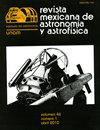SDSS-IV MANGA: THE RADIAL DISTRIBUTION OF PHYSICAL PROPERTIES WITHIN GALAXIES IN THE NEARBY UNIVERSE
IF 1.7
4区 物理与天体物理
Q3 ASTRONOMY & ASTROPHYSICS
Revista Mexicana de Astronomia y Astrofisica
Pub Date : 2023-09-01
DOI:10.22201/ia.01851101p.2023.59.02.06
引用次数: 0
Abstract
Using the largest sample of galaxies observed with an optical integral field unit (IFU, the SDSS-IV MaNGA survey, ≈10000 targets), we derive the radial distribution of the physical properties obtained from the stellar continuum and the ionized-gas emission lines. Given the large sample, we are able to explore the impact of the total stellar mass and morphology by averaging those radial distributions for different bins of both global properties. In general, we find that most of the properties exhibit a negative gradient, with a secondary impact by global properties. Our results confirm the intimate interplay between the properties of the stellar component and those of the ionized gas at local (kpc) scales to set the observed radial gradients. The resemblance of the gradients for similar global properties indicates statistical similar histories of star formation and chemical enrichment, with an initial radial gas distribution following the potential of the galaxy.Sdss-iv漫画:附近宇宙中星系内物理性质的径向分布
利用光学积分场单位观测到的最大星系样本(IFU, SDSS-IV MaNGA调查,≈10000个目标),我们推导了从恒星连续统和电离气体发射线获得的物理性质的径向分布。考虑到大样本,我们能够通过平均这些径向分布来探索总恒星质量和形态的影响。一般来说,我们发现大多数属性呈现负梯度,并受到全局属性的二次影响。我们的结果证实了恒星成分的性质与电离气体的性质之间的密切相互作用,在局部(kpc)尺度上设定了观测到的径向梯度。相似的全局性质梯度的相似性表明恒星形成和化学富集的统计相似的历史,初始径向气体分布跟随星系的潜力。
本文章由计算机程序翻译,如有差异,请以英文原文为准。
求助全文
约1分钟内获得全文
求助全文
来源期刊

Revista Mexicana de Astronomia y Astrofisica
地学天文-天文与天体物理
CiteScore
1.30
自引率
10.00%
发文量
14
审稿时长
>12 weeks
期刊介绍:
The Revista Mexicana de Astronomía y Astrofísica, founded in 1974, publishes original research papers in all branches of astronomy, astrophysics and closely related fields. Two numbers per year are issued and are distributed free of charge to all institutions engaged in the fields covered by the RMxAA.
 求助内容:
求助内容: 应助结果提醒方式:
应助结果提醒方式:


